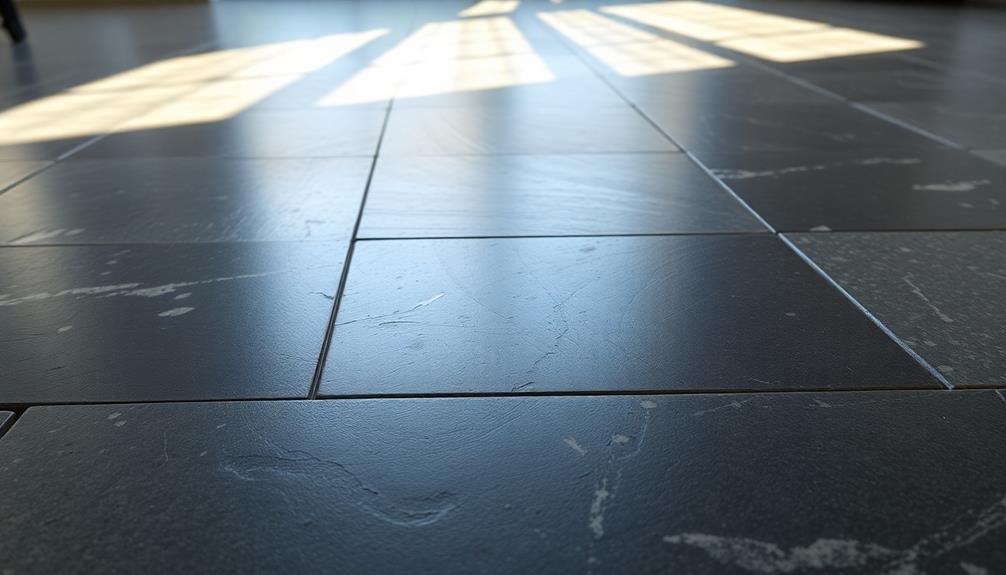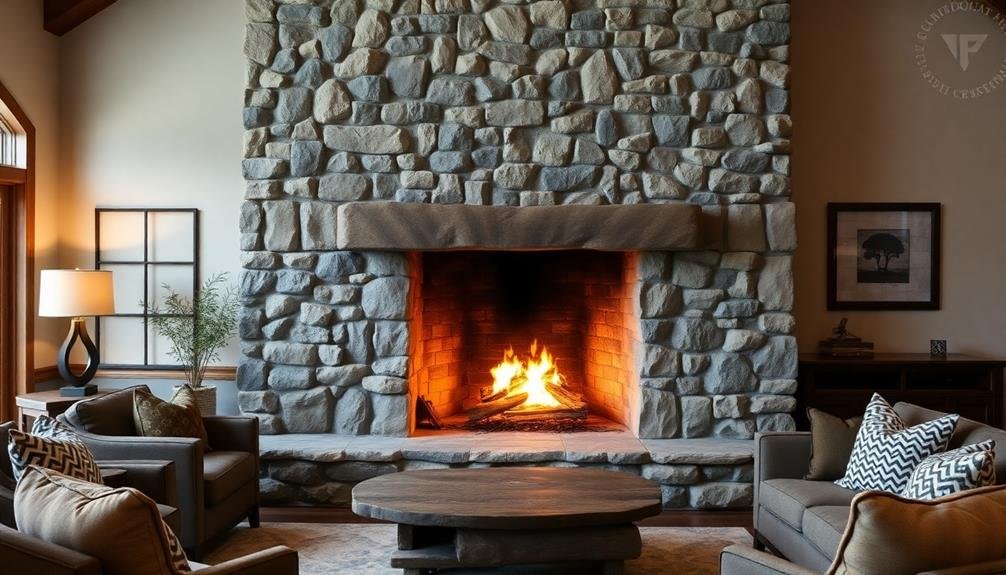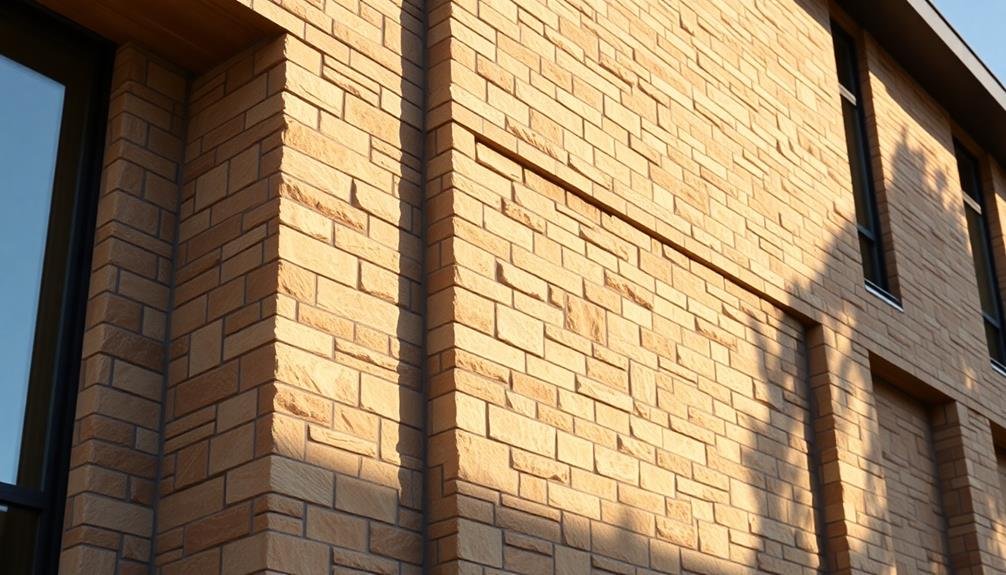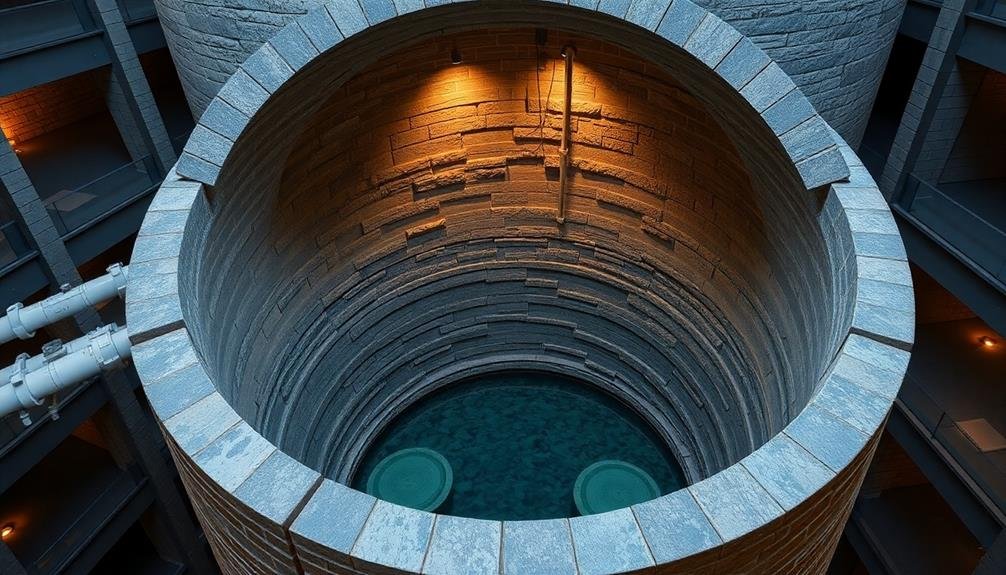You'll find several effective stone applications for thermal regulation in architecture. Stone flooring absorbs heat during the day and releases it at night, while thermal stone walls enhance insulation year-round. Stone fireplaces act as heat reservoirs, storing and distributing warmth efficiently. Countertops made of stone help stabilize indoor temperatures by absorbing excess heat. Exterior stone cladding provides natural insulation, reducing cooling costs. Stone roof tiles manage heat effectively in hot climates. Finally, stone-lined thermal storage tanks integrate with heating and cooling systems for consistent indoor comfort. Explore these options to harness stone's thermal properties in your architectural designs.
Stone Flooring for Heat Absorption

When it comes to thermal regulation in architecture, stone flooring is an excellent choice for heat absorption. You'll find that dense stones like granite, marble, and slate are particularly effective at storing thermal energy. These materials have high thermal mass, allowing them to absorb heat during the day and release it slowly at night, helping to maintain a stable indoor temperature.
To maximize heat absorption, you should consider dark-colored stones, as they absorb more solar radiation than lighter ones. However, be aware that this may lead to uncomfortably warm floors in direct sunlight. You can mitigate this by strategically placing rugs or using radiant floor heating systems in colder climates.
The thickness of the stone also plays a vital role in its heat absorption capabilities. Thicker slabs will store more heat, but they'll also take longer to warm up and cool down. You'll need to balance this with your specific climate and building design.
When installing stone flooring for heat absorption, guarantee proper insulation beneath to prevent heat loss to the ground. This will improve the overall efficiency of your thermal regulation system.
Thermal Stone Walls
When considering thermal stone walls, you'll find they excel at both heat absorption and storage.
These walls can greatly boost your building's insulation, leading to improved energy efficiency.
You'll notice that properly designed stone walls can help regulate indoor temperatures, keeping spaces cooler in summer and warmer in winter.
Heat Absorption and Storage
Stone walls, silent sentinels of architectural history, excel at heat absorption and storage.
You'll find that their high thermal mass allows them to absorb heat during the day and release it slowly at night, creating a natural temperature regulation system. This property makes stone walls particularly effective in climates with significant day-night temperature swings.
When you're designing with stone, consider the color and texture of the material.
Darker stones absorb more heat, while lighter ones reflect it. Rough surfaces increase the surface area for heat absorption, enhancing the wall's thermal performance.
You can maximize the benefits of stone's heat storage capacity by strategically placing windows and openings.
This allows sunlight to directly hit the stone surfaces during winter, warming the interior. In summer, you'll want to shade these surfaces to prevent overheating.
Insulation and Energy Efficiency
Building on stone's heat absorption properties, let's explore its role in insulation and energy efficiency. When you incorporate stone walls into your building design, you're not just adding aesthetic appeal; you're creating a thermal barrier that can greatly reduce energy costs. Stone's high thermal mass helps regulate indoor temperatures, keeping your space cooler in summer and warmer in winter.
To maximize stone's insulating potential, consider these factors:
| Stone Type | Insulation Value | Best Application |
|---|---|---|
| Granite | Moderate | Exterior facades |
| Limestone | High | Interior walls |
| Slate | Low | Roofing |
| Sandstone | Moderate | Flooring |
| Marble | Low | Decorative accents |
You'll find that combining stone with modern insulation techniques can yield impressive results. For instance, you can create a thermal stone wall by sandwiching insulation between two layers of stone. This approach capitalizes on stone's thermal mass while enhancing its insulating properties. By strategically placing these walls in your building, you'll create a more energy-efficient structure that reduces your reliance on artificial heating and cooling systems.
Stone Fireplaces as Heat Reservoirs

A classic feature in many homes, stone fireplaces serve as more than just aesthetic focal points. They're excellent heat reservoirs, storing thermal energy and gradually releasing it into your living space. When you choose the right type of stone, you'll maximize this heat-retention capability.
Dense stones like granite, marble, and limestone are ideal for fireplaces due to their high thermal mass. These materials absorb heat slowly but retain it for extended periods, continuing to warm your room long after the fire has died down.
You'll find that soapstone, with its superior heat retention properties, is particularly effective.
To optimize your stone fireplace's thermal regulation, consider its placement and design. Position it centrally in your home to allow for even heat distribution.
Incorporate a larger stone surround or hearth to increase the heat-storing surface area. You can also add a heat exchanger or blower to circulate warm air more efficiently throughout your space.
Stone Countertops for Temperature Stabilization
Stone countertops can play a significant role in stabilizing indoor temperatures due to their impressive heat absorption properties.
You'll find that these dense surfaces readily absorb excess heat during warm periods, helping to cool your interior spaces naturally.
Conversely, when the ambient temperature drops, stone countertops slowly release stored heat, contributing to a more consistent and comfortable indoor climate.
Heat Absorption Properties
Heat absorption properties of stone countertops play an essential role in temperature stabilization within architectural spaces. You'll find that different types of stone have varying heat absorption capacities, which can greatly impact the thermal regulation of your indoor environment.
When selecting stone countertops for temperature stabilization, consider these key factors:
| Stone Type | Heat Absorption | Thermal Conductivity |
|---|---|---|
| Granite | High | Moderate |
| Marble | Moderate | High |
| Slate | Low | Low |
Granite's high heat absorption makes it excellent for maintaining consistent temperatures, while its moderate thermal conductivity prevents rapid heat transfer. Marble, with its moderate heat absorption and high thermal conductivity, can quickly distribute heat throughout the space. Slate, on the other hand, has low heat absorption and thermal conductivity, making it ideal for areas where you want to minimize temperature fluctuations.
You'll want to choose stone countertops based on your specific thermal regulation needs. In kitchens, granite's heat-resistant properties can help absorb excess heat from cooking appliances. For bathrooms, marble's ability to retain warmth can create a more comfortable environment. By strategically incorporating these stone materials, you can effectively manage your indoor climate and reduce energy costs.
Cooling Effect Indoors
While heat absorption properties of stone countertops are important, their cooling effect indoors is equally significant for temperature stabilization. You'll find that stone countertops, particularly those made from materials like granite or marble, can help maintain a cooler indoor environment during hot weather.
When you're in a room with stone countertops, you'll notice they feel cool to the touch. This is because stone has a high thermal mass, allowing it to absorb and store heat from the surrounding air. As a result, it can help lower the ambient temperature of your indoor space.
You'll benefit most from this cooling effect in areas with significant temperature fluctuations. During the day, the stone absorbs excess heat, preventing your room from becoming too warm. At night, it slowly releases this stored heat, helping to maintain a more stable temperature.
To maximize this cooling effect, you should consider installing stone countertops in areas that receive direct sunlight or near heat-generating appliances. You'll also find that lighter-colored stones are more effective at reflecting heat, further enhancing their cooling properties.
Exterior Stone Cladding

When it comes to thermal regulation in architecture, exterior stone cladding stands out as a powerful solution. You'll find that stone cladding acts as a natural insulator, helping to maintain consistent indoor temperatures throughout the year.
It's particularly effective in hot climates, where it can greatly reduce cooling costs by absorbing and slowly releasing heat.
You should consider using limestone, granite, or sandstone for your exterior cladding. These materials have high thermal mass, which means they can store heat during the day and release it at night, helping to regulate indoor temperatures.
They're also durable and weather-resistant, ensuring long-lasting performance.
When installing stone cladding, you'll want to pay attention to the air gap between the stone and the building's structure. This gap helps improve insulation and prevents moisture buildup.
You can also combine stone cladding with other energy-efficient features like double-glazed windows and proper ventilation to maximize its thermal regulation benefits.
Stone Roof Tiles
Stone roof tiles offer another excellent option for thermal regulation in architectural design. They're particularly effective in hot climates, where they can greatly reduce heat absorption and transfer into the building.
You'll find that stone tiles, especially those made from slate or limestone, have high thermal mass, allowing them to absorb heat during the day and release it slowly at night.
When you're considering stone roof tiles, you'll need to factor in their weight. Your building's structure must be capable of supporting the additional load. However, the benefits often outweigh this challenge.
Stone tiles are incredibly durable, often lasting for centuries with proper maintenance. They're also fire-resistant, adding an extra layer of safety to your building.
You can enhance the thermal performance of stone roof tiles by incorporating an air gap between the tiles and the roof deck. This creates a ventilation channel that further reduces heat transfer.
Additionally, you might consider lighter-colored stones for even better heat reflection. Remember, the effectiveness of stone roof tiles for thermal regulation depends on proper installation and the specific climate conditions of your location.
Stone-Lined Thermal Storage Tanks

An innovative application of stone for thermal regulation in architecture is the use of stone-lined thermal storage tanks. These tanks leverage stone's high thermal mass to store and release heat efficiently, helping to maintain stable temperatures in buildings throughout the day and night.
You'll find that stone-lined tanks can be integrated into various heating and cooling systems, including solar thermal and geothermal setups.
When you're considering stone-lined thermal storage tanks for your architectural project, keep these key benefits in mind:
- Enhanced thermal efficiency
- Reduced energy consumption
- Improved temperature stability
Stone's natural properties make it an excellent material for this application. It absorbs heat slowly during the day and releases it gradually at night, creating a more consistent indoor climate.
You can use various types of stone, such as granite, limestone, or slate, depending on your specific needs and local availability. The size and design of the tank will depend on your building's requirements and the climate in which it's located.
Frequently Asked Questions
How Does the Color of Stone Affect Its Thermal Properties?
You'll find that darker stones absorb more heat, while lighter ones reflect it. This affects their thermal properties considerably. Darker stones warm up faster and retain heat longer, impacting a building's temperature regulation throughout the day.
Are There Specific Stone Types Best Suited for Passive Solar Design?
You'll find that dense, dark-colored stones like slate, granite, and basalt are excellent for passive solar design. They absorb and retain heat well, slowly releasing it at night. Sandstone and limestone can also be effective choices.
What Maintenance Is Required for Stone Used in Thermal Regulation Applications?
You'll need to regularly clean and seal stone surfaces to maintain their thermal properties. You should inspect for cracks or damage, repair as needed, and guarantee proper ventilation. Don't forget to reapply sealants periodically to protect the stone.
How Do Stone Thermal Applications Impact Indoor Air Quality?
You'll find that stone thermal applications generally improve indoor air quality. They don't release harmful VOCs, can help regulate humidity, and may even trap pollutants. However, guarantee proper sealing to prevent mold growth in damp conditions.
Can Stone Thermal Regulation Be Effectively Combined With Modern HVAC Systems?
You can effectively combine stone thermal regulation with modern HVAC systems. They'll work together to enhance energy efficiency and comfort. Stone's thermal mass complements HVAC by reducing temperature fluctuations and lowering overall heating and cooling demands.
In Summary
You've now explored seven innovative ways to use stone for thermal regulation in architecture. From heat-absorbing floors to thermal storage tanks, these applications offer both aesthetic appeal and practical benefits. By incorporating stone into your designs, you'll enhance energy efficiency and create more comfortable living spaces. Whether you're building a new home or renovating, consider these stone applications to improve thermal performance and add timeless beauty to your architecture.





Leave a Reply